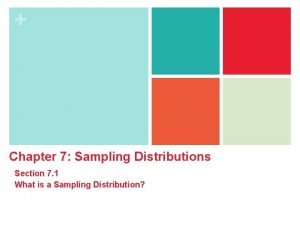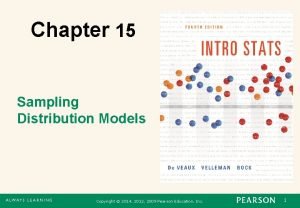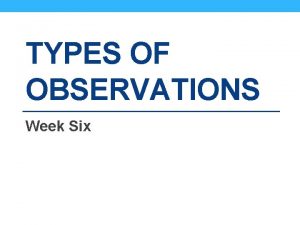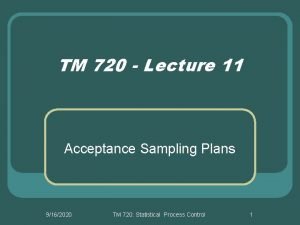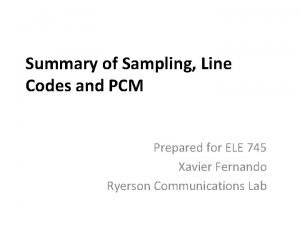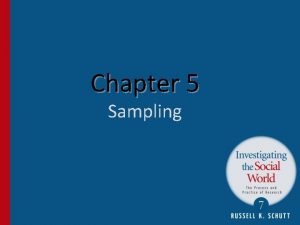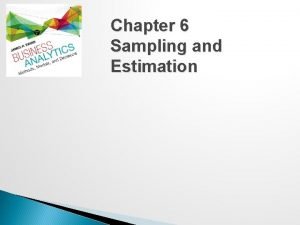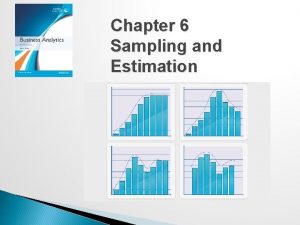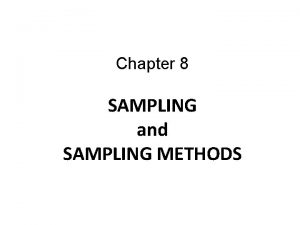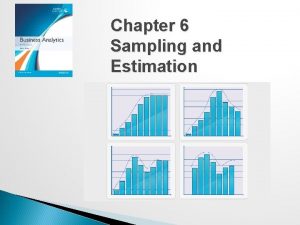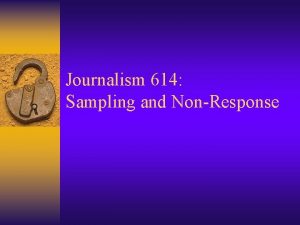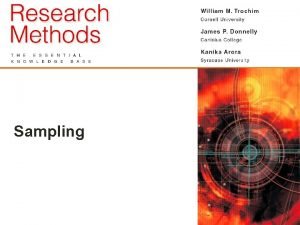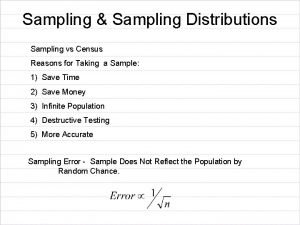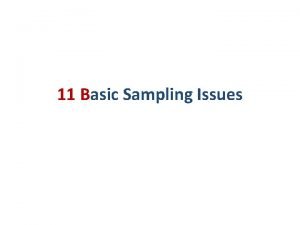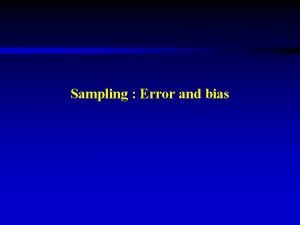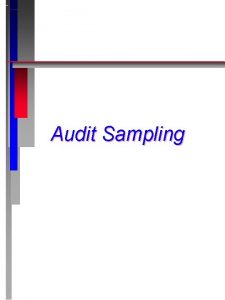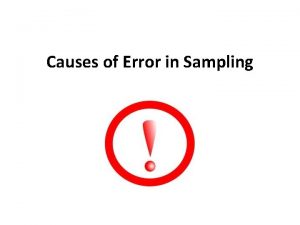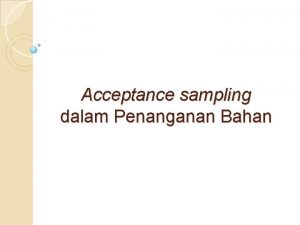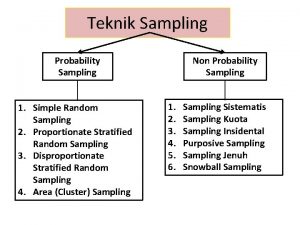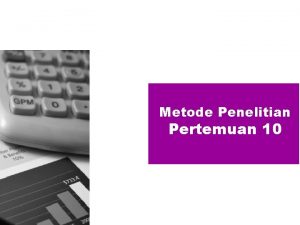Chapter 3 Sampling Techniques Chapter 3 Sampling Techniques










































- Slides: 42

Chapter 3 Sampling Techniques

Chapter 3 – Sampling Techniques When conducting a survey, it is important to choose the right questions to ask and to select the appropriate group to survey.

It is usually impractical to survey every member of a target group or population, so only a sample of the population is surveyed.

The population refers to all individuals or items that belong to a group being studied.

The sample refers to a group of individuals or items that are representative of the population from which they are taken.

For example, prior to an election it is impossible to predict the result of the election by asking EVERY person in the country who they’ll vote for.

Therefore, a sample of the population is chosen, and each of the people in that sample are asked who they intend to vote for.

Bias

Bias n It’s important to make sure that the sample is representative, otherwise we could get biased results


n That’s what happened when the Chicago Daily Tribune reported that Dewey defeated Truman in 1948.

n. A survey contains bias if it does not reflect the population.

n Bias may be caused by 1) an unrepresentative sample, or 2) the wording of the survey questions, and/or 3) the interpretation and presentation of the results.

Let’s talk about an unrepresentative sample first.

n Why would someone perform a survey and choose a sample that is not representative?

2 main reasons

n. Time flies

and

n. Money

n Sometimes there just isn’t enough time or money to do everything in the best possible way.

Various Sampling Techniques

Here are some examples of samples that may be used.

1. Simple Random Sample u. In a simple random sample, each member of the population has an equal chance of being selected. →

Example u Suppose the principal wants to determine how different teachers at Massey feel about a certain issue. She doesn’t have time to interview all 90 teachers, so instead she puts all 90 names in a hat, and draws some of those names, and then asks each of them.

Pros and Cons u What are advantages of using a simple random sample? u What are disadvantages?

2. Stratified Random Sample ►In a stratified random sample, the population is divided into subgroups (for example, by gender, age, nationality), and a random sample is selected from each subgroup in proportion to its size in the population. →

Example ► Go back to our last example. Suppose the principal wants to stratify her sample, so that she doesn’t get all men, or all women, or all old teachers, or all young teachers, etc. One thing she could do is … →

► She could divide all the teachers in the school into four categories 1. 2. 3. 4. Newer female teachers Newer male teachers More experienced female teachers More experienced male teachers. →

► Then, rather than putting the names in one big hat, the principal could put the names in four little hats. Then, she could take one quarter of the names that she needs from each hat.

Pros and Cons ► What are advantages of using a stratified random sample? ► What are disadvantages?

3. Voluntary-Response Sample n In a voluntary-response sample, the sample contains those members of the population who have chosen to respond to the survey. →

Example n The principal could put some blank response sheets on the table in the staff room with an invitation to all teachers to return them to her. Then, hopefully, the responses that she gets from the teachers that choose to respond will be representative of the feelings of the whole group.

Pros and Cons n n What are advantages of a voluntaryresponse sample? What are disadvantages?

4. Cluster Sample • In a cluster sample, the population is divided into clusters and a certain number of clusters are chosen. Every member of these clusters is part of the sample. →

Example • Suppose the principal decided that she would wait until a P. A. Day. Then, when the departments were having their meetings, she would go to three of the departments and ask what the teachers think of the issue. For example, she might go to the science department, the family studies department, and the phys. ed. department.

Pros and Cons • What are advantages of a cluster sample? • What are disadvantages?

5. Convenience Sample l In a convenience sample, the sample contains those members of the population from which data are most easily collected. →

Example l Perhaps the principal will ask the first ten teachers that she sees at school the next day what they think of the issue.

Pros and Cons l l What are advantages of a convenience sample? What are disadvantages?

6. Systematic Sample n. In a systematic sample, every nth member of the population is selected. →

Example n Perhaps the principal will list all the teachers in alphabetical order, then ask the 10 th teacher on the list, the 20 th teacher, the 30 th teacher, and so on until she was done.

Pros and Cons n What are advantages of a systematic sample? n What are disadvantages?
 Probability vs non probability sampling
Probability vs non probability sampling Cluster sampling advantages and disadvantages
Cluster sampling advantages and disadvantages Cluster v stratified sampling
Cluster v stratified sampling Contoh time sampling dan event sampling
Contoh time sampling dan event sampling Cluster sampling vs stratified random sampling
Cluster sampling vs stratified random sampling Non-probability sampling method
Non-probability sampling method Natural sampling vs flat top sampling
Natural sampling vs flat top sampling Homogeneous sampling qualitative research
Homogeneous sampling qualitative research Sampling methods psychology
Sampling methods psychology Sampling techniques
Sampling techniques Sampling techniques
Sampling techniques Sampling techniques
Sampling techniques Sampling techniques in qualitative research
Sampling techniques in qualitative research Fonctions et solutions techniques
Fonctions et solutions techniques Chapter 7 sampling distributions
Chapter 7 sampling distributions Chapter 17 sampling distribution models
Chapter 17 sampling distribution models Ap stats chapter 17 sampling distribution models
Ap stats chapter 17 sampling distribution models Ap stats chapter 17 sampling distribution models
Ap stats chapter 17 sampling distribution models Chapter 8 telephone techniques
Chapter 8 telephone techniques Chapter 15:7 cleaning with an ultrasonic unit
Chapter 15:7 cleaning with an ultrasonic unit Section 15-2 dry cooking techniques
Section 15-2 dry cooking techniques Define a routing list as it pertains to incoming calls
Define a routing list as it pertains to incoming calls Chapter 7 techniques of integration
Chapter 7 techniques of integration Chapter 15 infection control
Chapter 15 infection control Chapter 15:8 using sterile techniques
Chapter 15:8 using sterile techniques Chapter 9 capital budgeting techniques solutions
Chapter 9 capital budgeting techniques solutions Chapter 26 baking techniques answers
Chapter 26 baking techniques answers Chapter 14:3 washing hands
Chapter 14:3 washing hands Chapter 15:4 observing standard precautions
Chapter 15:4 observing standard precautions Chapter 8 worksheet bandaging and taping
Chapter 8 worksheet bandaging and taping Contoh soal work sampling
Contoh soal work sampling Wso work sampling
Wso work sampling Variable sampling adalah
Variable sampling adalah Visual basic application
Visual basic application Example of narrative observation on a child
Example of narrative observation on a child Generic purposive sampling
Generic purposive sampling Dependent samples
Dependent samples Acceptance sampling procedure
Acceptance sampling procedure Non probability sampling self selection
Non probability sampling self selection Texture synthesis by non-parametric sampling
Texture synthesis by non-parametric sampling Probability sampling adalah
Probability sampling adalah Convenience sampling
Convenience sampling Impulse sampling
Impulse sampling














